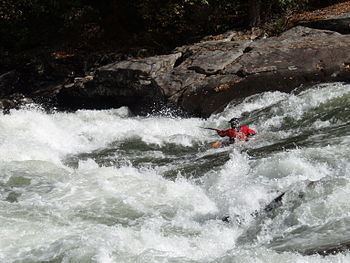- elevation 4,000 ft (1,219 m) - elevation 3,937 ft (1,200 m) Discharge 75.89 m³/s Source Gauley Mountain | Length 169 km | |
 | ||
- location Gauley Mountain, Pocahontas County, WV Cities | ||
Hd upper gauley river rivermen west virginia whitewater rafting
The Gauley River is a 105-mile-long (169 km) river in West Virginia. It merges with the New River to form the Kanawha River, a tributary of the Ohio River. It is one of the most popular advanced whitewater runs in the Eastern United States and is the chief feature of the Gauley River National Recreation Area.
Contents
- Hd upper gauley river rivermen west virginia whitewater rafting
- Map of Gauley River West Virginia USA
- Ace adventure resort upper gauley river rafting
- Headwaters and courseEdit
- TributariesEdit
- DamsEdit
- Whitewater paddlingEdit
- RapidsEdit
- HistoryEdit
- NameEdit
- References
Map of Gauley River, West Virginia, USA
Ace adventure resort upper gauley river rafting
Headwaters and courseEdit
The Gauley rises in the Monongahela National Forest on Gauley Mountain in Pocahontas County as three streams, the North, Middle, and South Forks, each of which flows across the southern extremity of Randolph County; they converge in Webster County. The river then flows generally west-southwestwardly through Webster, Nicholas and Fayette counties, past the towns of Camden-on-Gauley and Summersville, to the town of Gauley Bridge, where it joins the New River to form the Kanawha River. Via the Kanawha and Ohio rivers, it is part of the Mississippi River watershed.
TributariesEdit
The Gauley's largest tributaries all flow into the main river from the east (flowing in a westerly direction) and are described as follows:
DamsEdit
In Nicholas County, the Gauley is impounded by the Summersville Dam, a U.S. Army Corps of Engineers dam, to form Summersville Lake. The Gauley River National Recreation Area is downstream of the dam.
Whitewater paddlingEdit
The Gauley is run year-round by recreational boaters and from spring to fall by commercial rafting companies. During the majority of the year, boating is dependent on water level, which fluctuates dramatically depending on rainfall and the level of Summersville Lake. However, starting the Friday after Labor Day, the Army Corps of Engineers provides a series of twenty-two controlled releases for the express purpose of downriver recreation. These releases are collectively known as "Gauley Season" and are scheduled on six successive weekends, the first five of which are four-day weekends (Friday through Monday) and the last of which is just Saturday and Sunday. Typical release levels during "Gauley Season" range from 2,400 to 2,800 ft³/s (68 to 79 m³/s).
These releases are the result of an act of the U.S. Congress, the first law passed in the U.S. to specifically mandate recreational whitewater dam releases. The releases bring millions of dollars annually to the local economy, as paddlers travel from all over the United States and overseas for this event.
The Gauley has two commonly run sections: the more difficult 9.8-mile (15.8 km) Upper Gauley (Class IV-V), and the easier 11-mile (18 km) Lower Gauley (Class III-IV, V). Portions of the 5.5-mile (8.9 km) Middle Gauley (Class III+, IV) are commonly run in conjunction with either the Upper or Lower Gauley, and it is sometimes run alone as a milder alternative.
RapidsEdit
There are dozens of rapids on the Upper Gauley; the most notable are the "Big Five":
The Middle/Lower Gauley has fewer rapids and they are more spread out, but it also features big dramatic rapids that pose significant challenges. The list of Middle/Lower Gauley rapids includes:
HistoryEdit
The Gauley area was the site of the Battle of Carnifex Ferry on September 10, 1861, a Union victory in the American Civil War.
NameEdit
The Gauley River's name most likely is derived from Gaul, a historical region of Europe.
According to the Geographic Names Information System, the Gauley River has also been known as:
